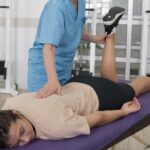

Spinal stenosis is a common degenerative process that can cause pain in the back, buttocks, and legs. It can cause limited ability to stand and walk because of pain, numbness, pins and needles and weakness. This blog post is designed to help you understand lumbar spinal stenosis and discusses treatments that work.
Spinal stenosis means narrowing around the spinal canal. This usually occurs because of degenerative changes that take place as people age. Just like skin wrinkles, spines develop bulging disks, bone spurs and thickened ligaments. These degenerative changes can narrow the spinal canal and can pinch nerves. This process may cause nerves to dysfunction creating pain, numbness and/or weakness.
Spinal stenosis can cause back, buttock and leg pain that are worse standing and walking. The symptoms are alleviated sitting, pushing a shopping cart and walking with a walker. Sometimes the symptoms can run down the back of both legs and other times can begin one leg in the distribution of one nerve, such as the side of the leg to the big toe.
Using a clinical history with symptoms in the proper location, triggered by standing and walking and alleviated sitting. Using a physical exam that assesses leg strength, sensation, reflexes, flexibility, and spinal motion. X-rays and an MRI can take detailed pictures of the low back and confirm the clinical diagnosis.
When people first get spinal stenosis, symptoms may come and go. If the process degenerates further, the symptoms can become permanent.
Initial good recommendations are to sit down when standing or walking becomes too painful, use a walker when walking distance, and go to physical therapy. Physical therapy can be helpful to improve flexibility, balance, leg strength and endurance. You should seek medical care if pain limits function, causes leg weakness, or continues to be symptomatic.
The initial treatment may be an epidural steroid injection (Sara- hyper link to my website the section on epidural steroid injections). This is low risk procedure that uses live time Xray to guide an injection of steroid and analgesic medicine adjacent to the pinched nerve. Sometimes this treatment is effective and other times it is not. If it is ineffective, is time to consider surgical treatments.
Surgical treatment may involve decompression of the pinched nerve which is often referred to as laminectomy. In this process bones and ligaments are removed to make more room for the nerves. Decompression can be minimally invasive and quite helpful. When patients have spinal deformities, such as slipped vertebrae (spondylolisthesis) or scoliosis, the surgery requires not only decompression, but may also require fusion. Fusion means connecting one or more levels of the spine together with screws, rods, and a bone graft. Fusion is a bigger surgery than decompression.
It depends. When there are severely pinched nerves in healthy people who have an easy surgical option, early surgery may be a good option. If people have severe nerve damage such as weakness or bowel or bladder incontinence, early surgical intervention is indicated. If the surgical option is extensive and invasive, or a person has significant medical issues and surgery should be used as a last resort.